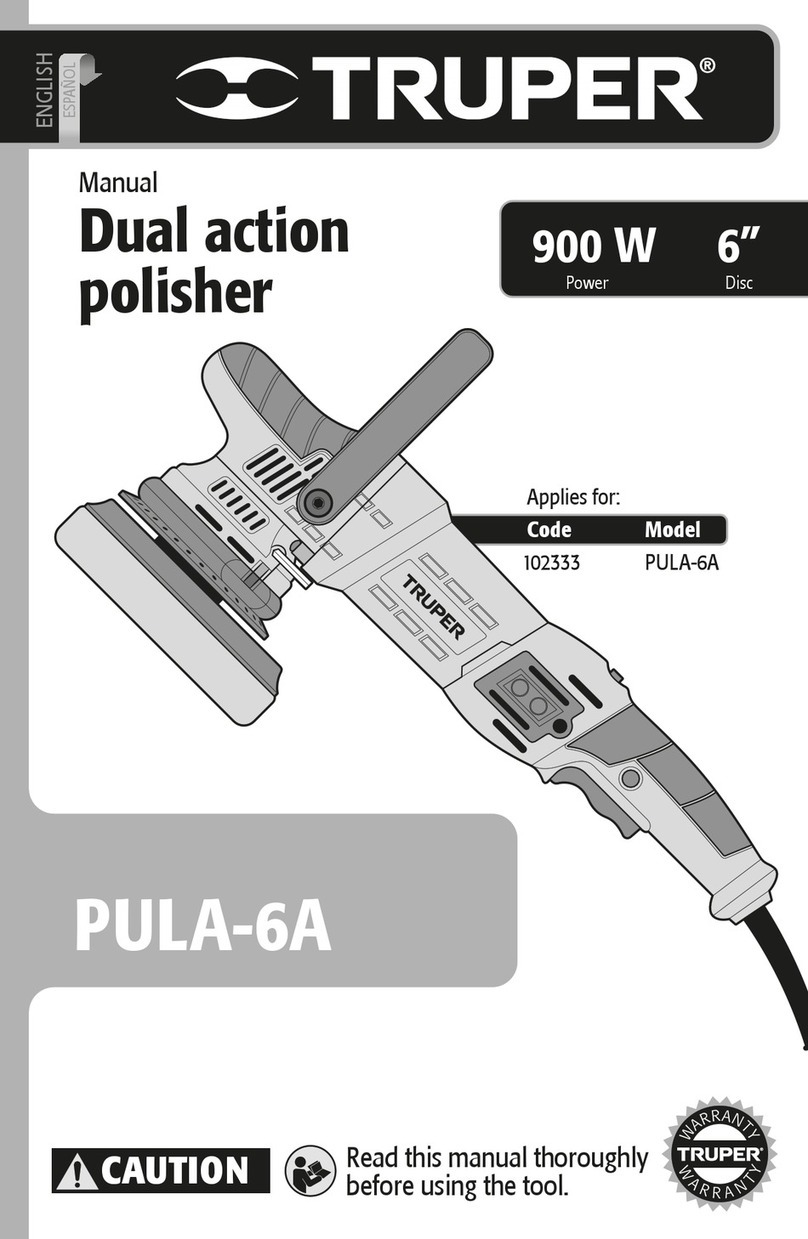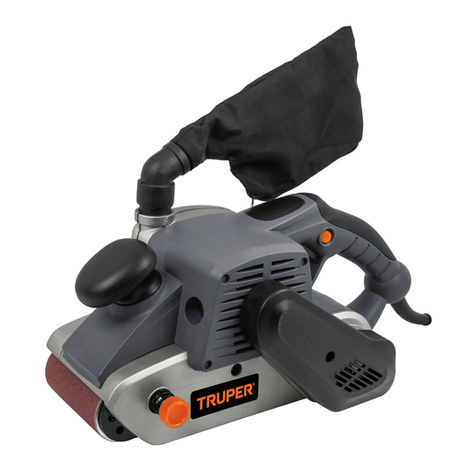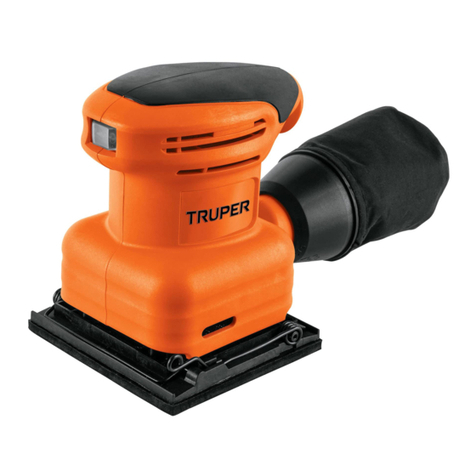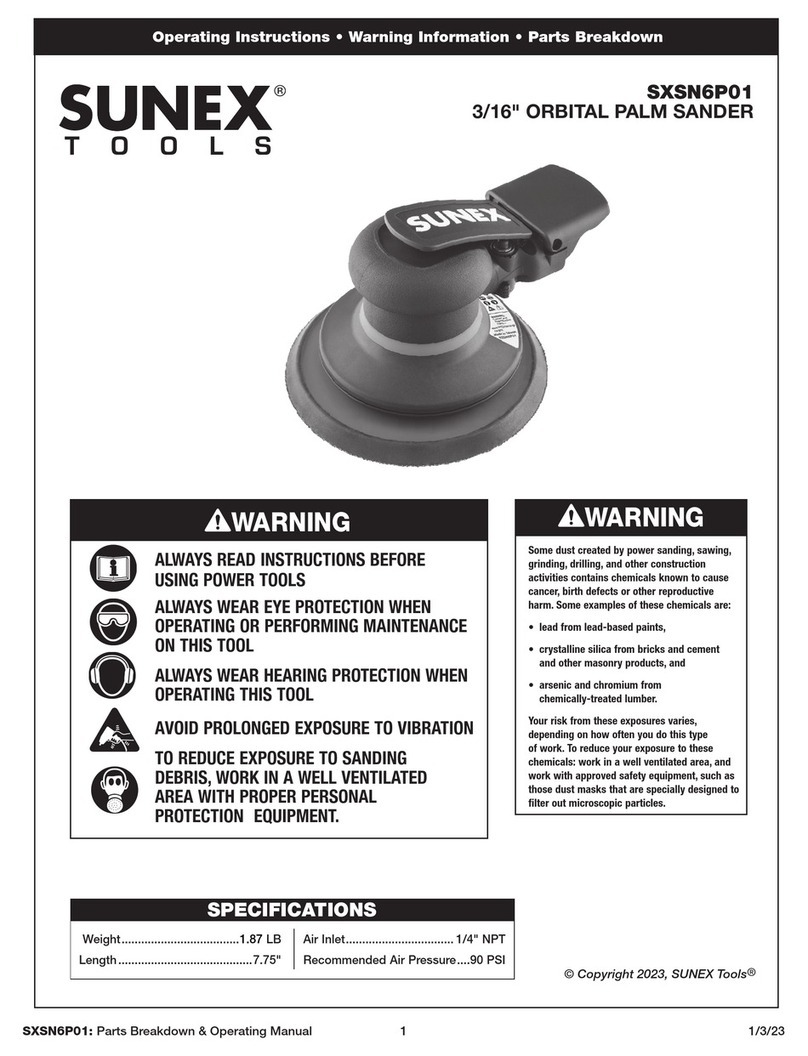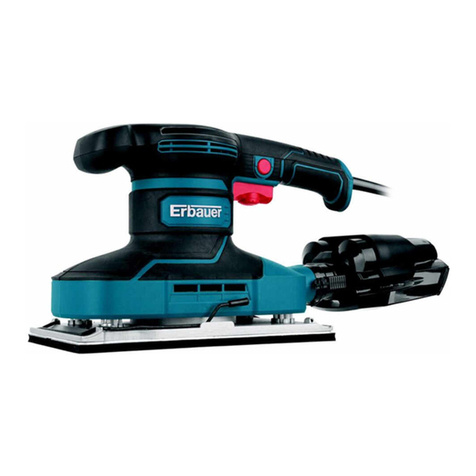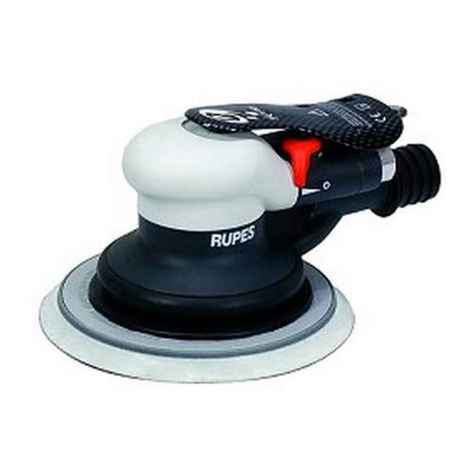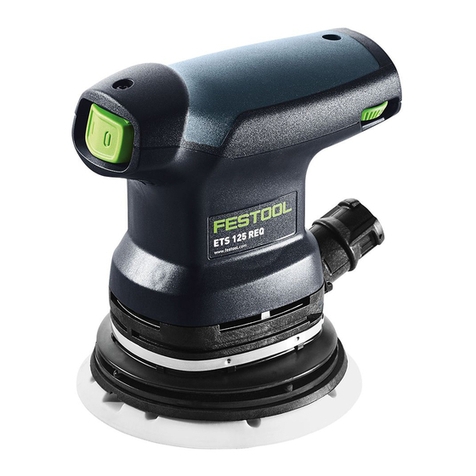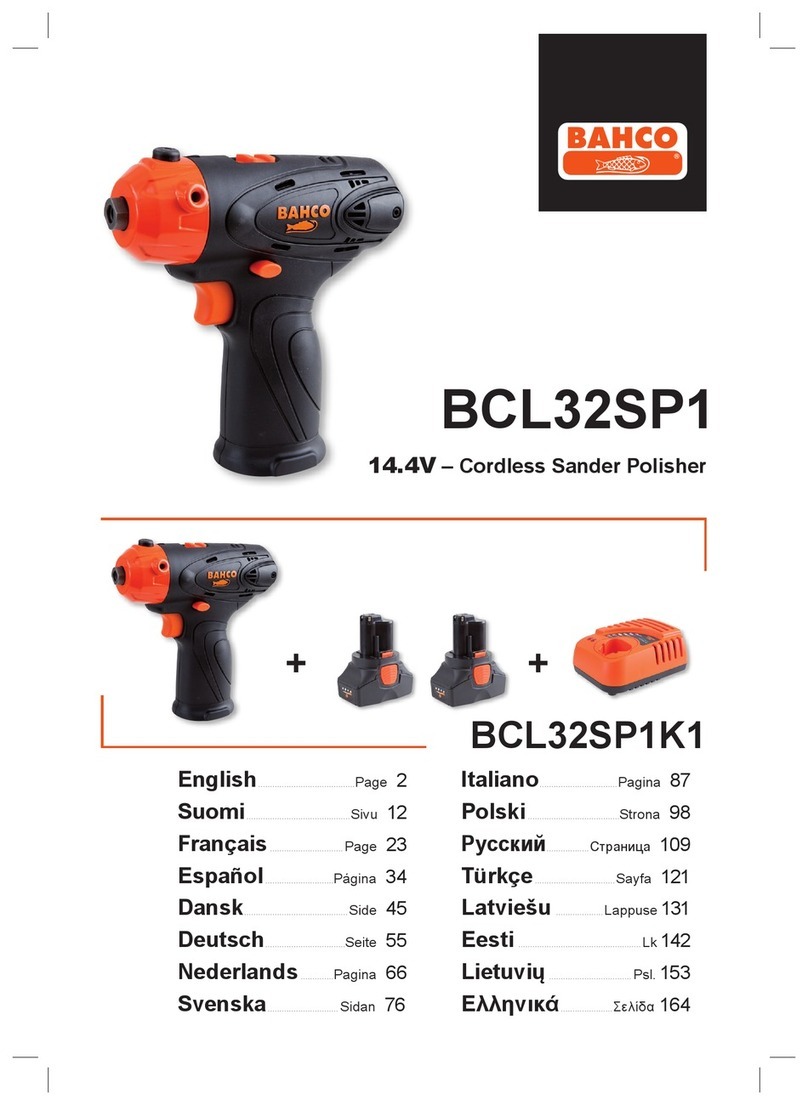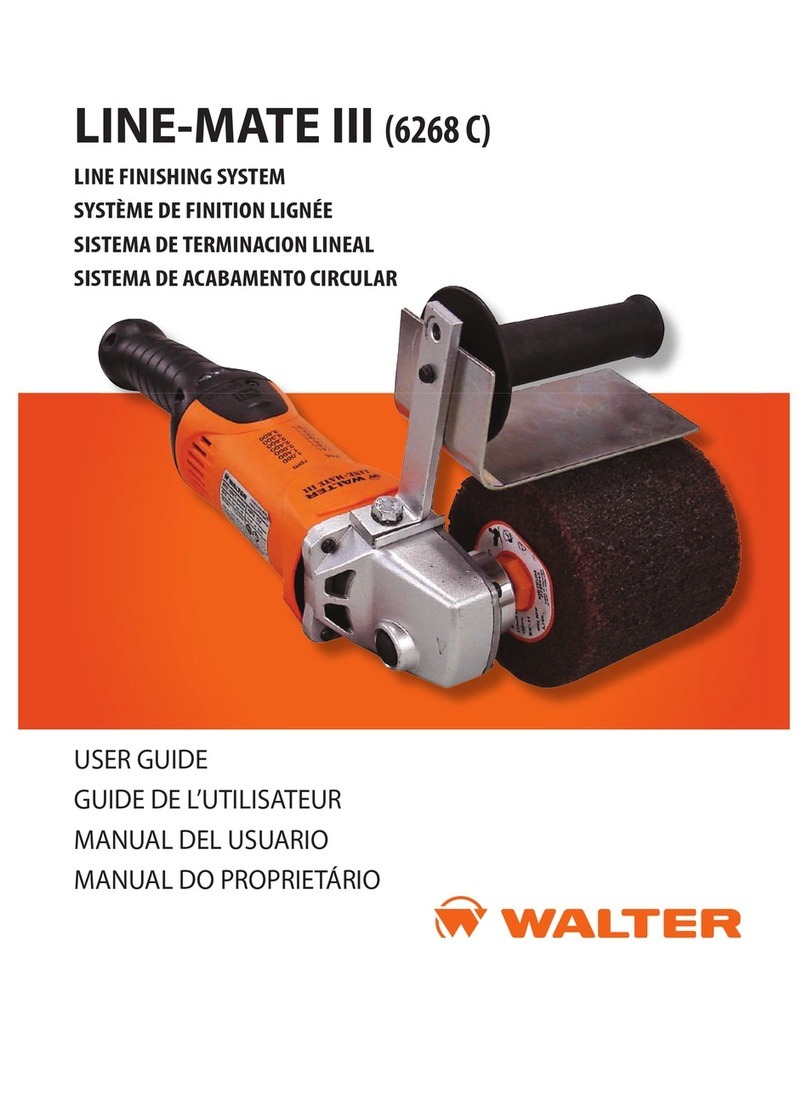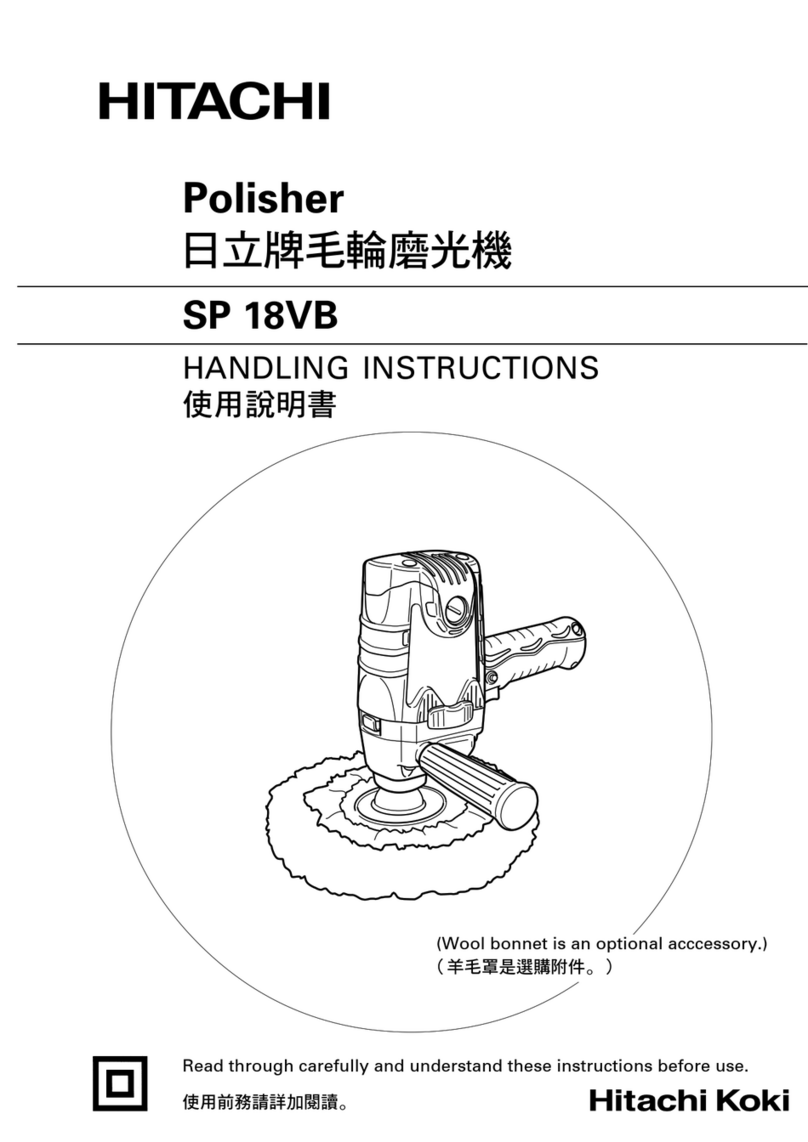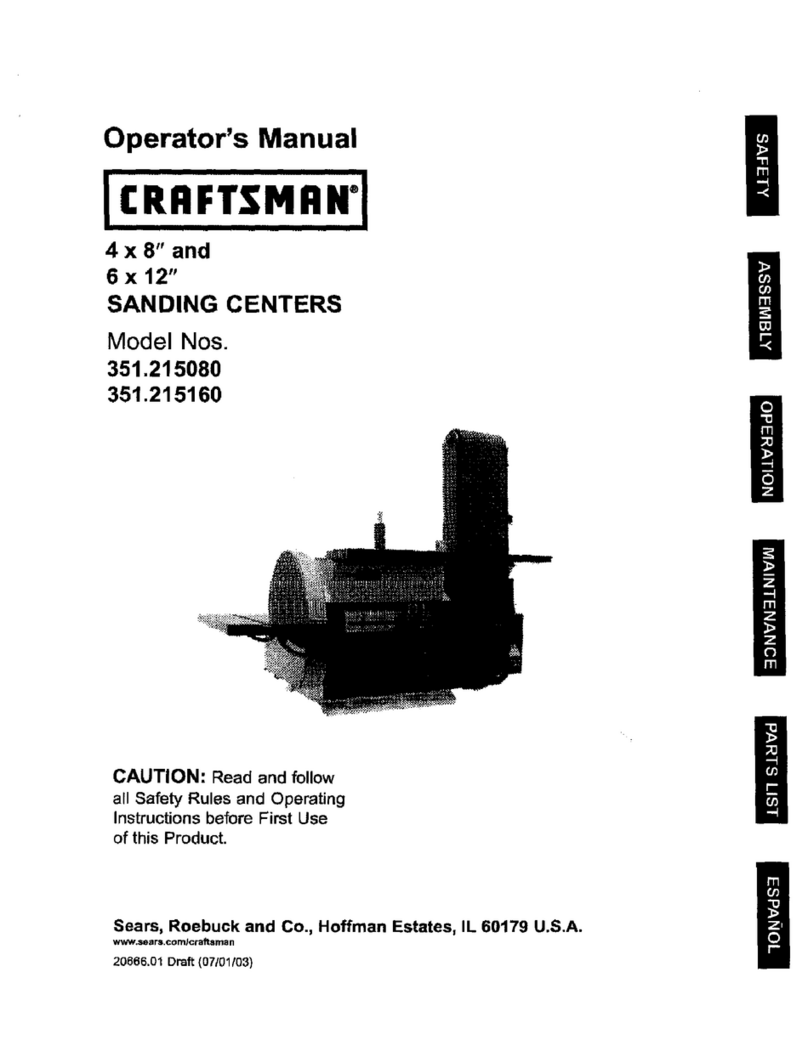Truper PUL-4X6T User manual

ON
Instructivo de
Lijadora
de banda
PUL-4X6T
Modelo Código
PUL-4X6T
Este Instructivo es para:
12110
375 W
1/2 Hp
ESPAÑOL
ENGLISH
Lea este instructivo por completo
antes de usar la herramienta.
ATENCIÓN

Í
ndice
2
Especificaciones técnicas
Requerimientos eléctricos
Advertencias generales de seguridad
para herramientas eléctricas
Advertencias de Seguridad
para uso de lijadoras de banda
Partes
Montaje
Puesta en marcha
Mantenimiento
Solución de problemas
Centros de Servicio Autorizados
Sucursales
Póliza de Garantía
3
3
4
5
5
6
8
9
9
10
12
12
PUL-4X6T
Guarde este Instructivo para futuras referencias.
Los gráficos de este Instructivo son para
referencia, pueden variar del aspecto real de la
herramienta.
Para poder sacar el máximo
provecho de la herramienta,
alargar su vida útil, hacer válida
la garantía en caso de ser
necesario y evitar riesgos o
lesiones graves, es fundamental
leer este Instructivo por
completo antes de usar la
herramienta.
ATENCIÓN
ESPAÑOL

A
B
3
PUL-4X6T
Especificaciones técnicas
Requerimientos eléctricos
12110
Lijadora de banda
Código
Descripción
autoadherible de 152,4 mm (6”) de diámetro
Banda
Disco
101,6 mm x 914 mm (4" x 36")
Clase I
60 Hz
18 AWG x 3C con temperatura de aislamiento de 105 °C
banda: 600 m/min (1 969 fpm) | disco: 3 500 r/min (RPM)
4,5 A
375 W (1/2 HP)
Tensión
Frecuencia
Corriente
Potencia
Velocidad
Conductores
Aislamiento IP20
Grado IP
El cable de alimentación tiene sujeta-cables tipo: Y
La clase de construcción de la herramienta es: Aislamiento básico.
La clase de aislamiento térmico de los devanados del motor: Clase B
120 V
ESPAÑOL
Si el cable de alimentación se daña, éste debe ser reemplazado por el fabricante o Centro de Servicio
Autorizado , con el fin de evitar algún riesgo de descarga o accidente considerable.
La construcción del aislamiento eléctrico de esta herramienta es alterado por salpicaduras o
derramamiento de líquidos durante su operación. No la exponga a la lluvia, líquidos y/o humedad.
Antes de obtener acceso a las terminales, todos los circuitos de alimentación deben ser desconectados.
ADVERTENCIA
ADVERTENCIA
de 0 A hasta 10 A
de 10 A hasta 13 A
de 13 A hasta 15 A
de 15 A hasta 20 A
18 AWG
16 AWG
14 AWG
8 AWG
16 AWG
14 AWG
12 AWG
6 AWG
3 (uno a tierra)
de 1,8 m a 15 m | mayor de 15 m
Capacidad en
Amperes Número de
conductores Calibre de extensión
La herramienta debe ser conectada a tierra mientras esté en uso para evitar una descarga eléctrica.
• Enchufe la clavija dentro de un contacto o enchufe apropiadamente aterrizado
como se muestra en el ejemplo A. No todos los contactos o enchufes están
propiamente aterrizados, si no está seguro verifique con un eléctrico calificado.
• Si el contacto que planea usar para su herramienta es de 2 polos (2 orificios),
NO REMUEVA O ALTERE EL CONDUCTOR DE TIERRA DE SU CLAVIJA POR
NINGÚN MOTIVO. Utilice un adaptador temporal como se muestra en el
ejemplo By siempre conecte la oreja del conductor de tierra como se indica.
Al usar un cable de extensión, asegúrese de usar el calibre
suficiente para transportar la corriente que consumirá su herramienta. Un cable
de un calibre inferior ocasionará caídas de tensión en la línea, teniendo como
resultado pérdida de potencia y sobrecalentamiento del motor. La siguiente tabla
muestra el tamaño correcto que debe usarse dependiendo de la longitud del
cable y de la capacidad de amperes indicada en la placa de datos de la herramienta. Si tiene dudas use el siguiente calibre más alto.
ADVERTENCIA
ATENCIÓN
ATENCIÓN
Al operar herramientas eléctricas en exteriores, utilice una extensión aterrizada marcada como “Uso exterior”
marca Estas extensiones son especiales para el uso en exteriores y reducen el riesgo de sufrir una descarga eléctrica.
ADVERTENCIA
*Se permite utilizarlo siempre y cuando las extensiones mismas cuenten con un artefacto de protección contra sobrecorriente.
AWG = Calibre de alambre estadounidense (American Wire Gauge). Referencia: NMX-J-195-ANCE-2006

No exponga la herramienta a la lluvia o condiciones dehumedad.
No fuerce el cable. Nunca use el cablepara transportar,
levantar o desconectar la herramienta. Mantenga el cable
lejos del calor, aceite, orillas afiladas o piezas en movimiento.
El uso de una extensión adecuada para exteriores reduce el riesgo de choque
Un momento de distracción mientras maneja la herramientapuede
causar un daño personal
Las llaves o herramientas que quedanen las partes rotativas de la
herramienta pueden causar un daño personal
¡ADVERTENCIA! Lea detenidamente todas las advertenciasde seguridady todaslas instrucciones que se enlistan a continuación.
alguna de ellas puede dar como resultado un choque eléctrico, incendio y/o daño serio.
4
Advertencias generales de seguridad
para herramientas eléctricas
Área de trabajo
Mantenga el área de trabajo limpia y bien iluminada.
Las áreas desordenadas y obscuras son propensas a accidentes.
No maneje la herramienta en ambientes explosivos, como en
presencia de líquido, gas o polvo inflamables.
Las herramientas eléctricas producen chispas que pueden encender
material inflamable.
Mantenga alejados a los niños y curiosos cuando opere la
herramienta.
Las distracciones pueden hacer que pierda el control.
Seguridad eléctrica
La clavija de la herramienta debe coincidir con el tomacorrien-
te. Nunca modifique una clavija. No use ningún tipo de
adaptador para clavijas de herramientas puestas a tierra.
Clavijas modificadas y enchufes diferentes aumentan el riesgo de
choque eléctrico.
Evite el contacto del cuerpo con superficies puestas a tierra
como tuberías, radiadores, cocinas eléctricas y refrigeradores.
Hay un mayor riesgo de choque eléctrico si el cuerpo está puesto a tierra.
El agua que ingresa en la herramienta aumenta el riesgo de choque eléctrico.
Los cables dañados o enredados aumentan el riesgo de choque eléctrico.
Cuando maneje una herramienta en exteriores, use una
extensión especial para uso en exteriores.
eléctrico.
Si el uso de la herramienta en un lugar húmedo es inevitable,
use una alimentación protegida por un interruptor de circuito
de falla a tierra (GFCI).
El uso de un GFCI reduce el riesgo de choque eléctrico.
Seguridad personal
Esté alerta, vigile lo que está haciendo y use el sentido común
cuando maneje una herramienta. No la use si está cansado o
bajo la influencia de drogas, alcohol o medicamentos.
.
Use equipo de seguridad. Use siempre protección para los ojos.
El uso de equipo de seguridad como lentes de seguridad, mascarilla antipolvo,
zapatos antideslizantes, casco y protección para los oídos en condiciones
apropiadas, reduce de manera significativa los daños personales.
Evite arranques accidentales. Asegúrese de que el interruptor
está en posición “apagado” antes de conectar a la fuente de
alimentación y/o a la batería o transportar la herramienta.
Transportar herramientas eléctricas con el dedo sobre el interruptor o
conectar herramientas eléctricas que tienen el interruptor en posición de
“encendido” puede causar accidentes.
Retire cualquier llave o herramienta de ajuste antes de arrancar
la herramienta eléctrica.
.
No sobrepase su campo de acción. Mantenga ambos pies bien
asentados sobre el suelo y conserve el equilibrio en todo
momento.
Esto permite un mejor control de la herramienta en situaciones inesperadas.
Vista adecuadamente. No vista ropa suelta o joyas. Mantenga su
pelo, su ropay guantes alejados de las piezas en movimiento.
La ropaoel pelo sueltoso las joyas puedenquedar atrapados en
las piezas en movimiento.
En caso de contar con dispositivos de extracción y recolección
de polvo conectados a la herramienta, verifique sus conexiones
y úselos correctamente.
El uso de estos dispositivos reduce los riesgos relacionados con el polvo.
Uso y cuidados de la herramienta
No fuerce la herramienta. Use la herramienta adecuada para el
trabajo a realizar.
La herramienta adecuada hace un trabajo mejor y más seguro cuando
se usa al ritmo parael que fue diseñada.
No use la herramienta si el interruptor no funciona.
Cualquier herramienta eléctrica que no pueda encenderse o
apagarse es peligrosa y debe repararse antes de ser operada.
Desconecte la herramienta de la fuente de alimentación y/o de
la batería antes de efectuar cualquier ajuste, cambiar accesorios
o almacenarla.
Estas medidas reducen el riesgo de arrancar la herramienta accidentalmente.
Almacene las herramientas fuera del alcance de los niños y no
permita su manejo por personas no familiarizadas con las
herramientas o con las instrucciones.
Las herramientas eléctricas son peligrosas en manos no entrenadas.
Déle mantenimiento a la herramienta. Compruebe que las
partes móviles no estén desalineadas o trabadas, que no
haya piezas rotas u otras condiciones que puedan afectar su
operación. Repare cualquier daño antes de usar la herramienta.
Muchos accidentes son causados por el escaso mantenimiento de las
herramientas.
Mantenga los accesorios de corte afilados y limpios.
Los accesorios de corte en buenas condiciones son menos probables de
trabarse y más fáciles de controlar.
Use la herramienta, sus componentes y accesorios de acuerdo
con estas instrucciones y de la manera prevista para el tipo de
herramienta, en condiciones de trabajo adecuadas.
El uso de la herramienta para aplicaciones diferentes para las que
está diseñada podría causar una situación de peligro.
Servicio
Repare la herramienta en un Centro de Servicio Autorizado
usando sólo piezas de repuesto idénticas.
Para mantenerlaseguridad de laherramienta.
La máquina no debe de ser utilizada por niños ni por personas
con capacidades físicas, sensoriales o mentales reducidas;
tampoco por personas sin experiencia o conocimientos en su
uso, a menos que estén supervisadas por una persona
responsable de su seguridad o reciban instrucciones previas
sobre el uso de la máquina.
Los niños deben de estar bajo supervisión para asegurarse de que no jueguen
con la máquina. Se debe de mantener una estricta supervisión si niños o
personas discapacitadas llegan a utilizar cualquier tipo de aparato
electrodoméstico o estén cerca de él.
La omisión de
Conserve las advertencias y las instrucciones para futuras referencias.
ESPAÑOL Esta herramienta cumple
con la Norma Oficial
Mexicana (NOM).

ON
• Observe la regulaciones aplicables
cuando lije superficies pintadas. Tenga un cuidado especial
cuando la pintura contenga plomo.
• Retire el polvo y cualquier otro material de desecho para
tener un ambiente de trabajo seguro. En la medida de lo
posible, use una aspiradora o extractor para la recolección
de polvo.
• Todas las personas que estén en el
área de trabajo deben usar respiradores profesionales para
proteger a los usuarios contra el polvo y humo generados
al lijar.
• No use esta máquina para lijar piezas con magnesio.
• Utilice respiradores profesionales y
cartuchos marca adecuados para
trabajo con polvo y vapores de pintura. Las máscaras
ordinarias para pintura no ofrecen esta protección.
• Los niños y mujeres embarazadas
no deben entrar en el área de trabajo.
Guarda
del disco
Ducto de
extracción
de polvo
Seguro del
ángulo de la
cama de lijado
Escala de
ángulo de
la mesa
de trabajo
Mesa de
trabajo
Perilla de ajuste
de la mesa de trabajo
Banda
de lija
Disco de
aluminio
Disco
de lija
Perilla de
alineación
de la banda
de lija
Palanca
para tensión
de la banda de lija
Cama
de lijado
Guía angular
de 0° a 60°
Soporte de la
pieza de trabajo
Interruptor
Cubierta de
la banda de
transmisión
5
Advertencias de Seguridad
para uso de lijadoras de banda
• Utilice indumentaria adecuada. La
ropa suelta, joyas o cabello largo pueden ser atrapados por
las piezas móviles.
Utilice indumentaria adecuadaPrecauciones con polvo y residuos
Partes
ESPAÑOL
ATENCIÓN
ATENCIÓN
ATENCIÓN
ADVERTENCIA
ADVERTENCIA

A
B
C
D
1
ON
ON
Montaje
6
Disco de lija y guarda (A)
• La lijadora debe de fijarse a un banco de trabajo estable,
sólido, fijo, plano y nivelado antes de ponerse en marcha.
• Coloque la lijadora sobre el banco de trabajo, en la
posición más adecuada para trabajar. Considere un espacio
de por lo menos 30 cm (11,8”) de la mesa de trabajo de la
lijadora a cualquier pared u obstáculo, y en caso de trabajar
piezas largas, aún más, para evitar que las piezas de trabajo
topen y puedan hacerle perder el control de la herramienta.
• Marque con un lápiz los cuatro orificios de montaje sobre
la superficie del banco de trabajo.
• Retire la lijadora del banco de trabajo y realice dos
perforaciones de 9,5 mm (3/8”) de diámetro en las marcas
realizadas.
• Fije la lijadora al banco de trabajo con pernos de 7,9 mm
(5/16”) de diámetro, tuercas y rondanas planas (no
incluidas). Apriete gradualmente cada perno de uno en uno
para asentar perfectamente la base de la lijadora.
• Desprenda la protección del disco de lija autoadherible.
• Alinee el disco de lija con el disco de aluminio y péguelo
presionando firmemente.
• Coloque la guarda del disco en la parte inferior del disco
de lija, de manera que los orificios de montaje queden
alineados y fíjela con los dos tornillos de cabeza plana
incluidos.
Soporte de la pieza de trabajo (B)
• Coloque el soporte de la pieza de trabajo sobre la banda
de lijado como se muestra en el gráfico y asegúrelo con
los dos juegos de tornillo, rondana de presión y rondana
incluidos. No apriete excesivamente.
Mesa de trabajo (C)
• Fije el soporte (1) a la mesa de trabajo por medio de los
tres juegos de tornillo, rondana de presión y rondana
incluidos como se muestra en el gráfico. No apriete los
tornillos.
Mesa de trabajo (D)
• Coloque el soporte de la mesa en el orificio correspon-
diente que está al lado de la guía graduada.
• Inserté la perilla a través de la ranura del soporte de la
mesa y del orificio roscado inferior.
• Afloje los tornillos que fijan la mesa de trabajo al soporte
para ajustarla, de manera que quede perfectamente
paralela a la superficie del disco y haya un espacio máximo
de 1,5 mm (1/16”) entre el disco y la mesa. Apriete los
tornillos.
• Inserte la barra de la guía de inglete en la ranura de la
mesa de trabajo.
ESPAÑOL

ON
E
F
G
4
3
ON
7
Montaje
Mesa de trabajo para lijado vertical (E)
• Cuando la cama de lijado esté colocada en posición
vertical, puede instalar la mesa de trabajo en ella para
hacer más fácil y preciso la labor de lijado.
• Retire la mesa de trabajo de su posición para lijar con el
disco.
• Retire el soporte de la pieza de trabajo (B), para colocar
en su lugar el soporte de la mesa en el orificio
correspondiente.
• Inserté la perilla a través de la ranura del soporte de la
mesa y del orificio roscado inferior.
Ajuste de la mesa de trabajo (F)
• La mesa de trabajo debe de ser ajustada y calibrada
antes de comenzar con la labor de lijado.
• Coloque una escuadra de combinación sobre la
superficie de la mesa y contra la cara del disco para
asegurarse que la mesa se encuentre a 0°.
• En caso de que la mesa no esté nivelada afloje la perilla
de ajuste e incline la mesa hasta que quede a 0°.
• Una vez nivelada la mesa, apriete la perilla de ajuste.
• Desprenda la protección de la guía graduada
autoadherible y péguela junto al ducto de extracción de
polvo, asegúrese de hacer coincidir el 0 (cero) con el
puntero del soporte de la mesa.
Cambio de banda de lija (G)
• Apague y desconecte la lijadora.
• Levante la palanca de tensión (2) para aflojar los rodillos de
la banda de lija y levante la cama de lijado a 45°.
• Retire la banda de lija desgastada.
• Coloque la banda de lija nueva haciendo pasar ambos
rodillos por el interior de la banda.
• Asegúrese de que la flecha de dirección esté apuntando
hacia abajo, hacia el rodillo impulsor.
• Centre la banda en la cama de lijado.
• Mueva la palanca de tensión a la izquierda para que la
banda quede apretada.
• Apriete el seguro del ángulo de la cama de lijado (3).
• Conecte y encienda un momento la lijadora para
observar detenidamente el comportamiento de la banda.
En caso de que la banda se mueva hacia afuera de la cama
de lijado habrá que ajustarla.
• Si la banda se mueve hacia el disco, apague la lijadora y
gire la perilla de alineación (4) 1/4 de vuelta en el sentido
de las manecillas del reloj. Encienda la lijadora para
verificar y repita la operación de ser necesario hasta que la
banda se mueva en su lugar.
• Si la banda se aleja del disco, apague la lijadora y gire la
perilla de alineación 1/4 de vuelta en el sentido contrario
de las manecillas del reloj. Encienda la lijadora para
verificar y repita la operación de ser necesario hasta que la
banda se mueva en su lugar.
2
ESPAÑOL

ON
ON
ON
ON
ON
ON
ON
8
Puesta en marcha
Encendido y apagado
Procedimientos de lijado
• La lijadora tiene un interruptor con llave de seguridad
para prevenir el uso no autorizado. Si va a dejar la
máquina por un largo período de tiempo y existe la
posibilidad de que la usen personas sin capacitación,
especialmente niños, retire la llave de seguridad con el
interruptor en la posición de apagado (OFF). Deje la llave
en un lugar seguro, no la pierda o no podrá operar la
lijadora de nuevo.
• Para encender la lijadora, inserte la llave de seguridad y
levante el interruptor a la posición de encendido (ON).
• Para apagar la lijadora, baje el interruptor a la posición de
apagado (OFF).
• Asegúrese de que el interruptor
está en la posición de apagado (OFF) antes de conectar la
lijadora a la corriente eléctrica.
Llave de
seguridad
Lijado de
superficies Lijado de
cantos
Lijado de
bordes
curvos
Lijado de
bordes
curvos
Posición de
apagado (OFF)Posición de
encendido (ON)
ESPAÑOL
ADVERTENCIA

9
Mantenimiento
Solución de problemas
Mantenga siempre libres y limpias las aberturas de
ventilación de la cubierta del motor. Después de cada uso
aplique aire comprimido. En caso de falla recurra
únicamente a un Centro de Servicio Autorizado
.
Limpieza y cuidados
• Lubrique los bujes después de cada 10 horas de uso con
aceite grado 30.
• Mueva la palanca de tensión a la derecha, recorra la
banda de lijado ligeramente a la derecha o a la izquierda
del rodillo de giro libre para dejar expuesto el orificio de
lubricación ovalado (5).
• Aplique dos o tres gotas de aceite en los orificios de
lubricación de ambos lados del rodillo. Ajuste la alineación
de la banda como se describe en la página 7 (Cambio de
banda de lija).
Lubricación
• Con un desarmador afloje el tornillo de la cubierta de la
banda y retire la cubierta (6).
• Afloje los tres tornillos de la cubierta interna para acercar
ambas poleas (7).
• Coloque la banda alrededor de las poleas.
• Apriete ligeramente los tres tornillos de la cubierta interna.
• Ajuste la tensión de la banda impulsora colocando un
desarmador plano en el orificio de ajuste (8), empujando
el desarmador para aplicar tensión a la banda impulsora.
• Apriete firmemente los tres tornillos de la cubierta interna.
• Sujete la banda impulsora con dos dedos en la parte
exterior central y comprima. Debe ceder cerca de 6,3 mm
(1/4”) para que la banda impulsora tenga la tensión correcta.
• Una tensión excesiva en la banda
impulsora puede forzar el motor y ocasionar daños. Si la
banda impulsora está floja, puede fallar prematuramente.
• Vuelva a colocar la cubierta de la banda.
Cambio de la banda impulsora
La máquina no
funciona cuando se
prende.
El motor funciona
lentamente cuando
se lija.
La banda de lija corre
fuera de los rodillos.
La madera se quema
al lijarla.
La lijadora hace un
ruido excesivo.
• No hay suministro de energía.
• El cable de alimentación está defectuoso,
problema del motor o cableado.
• La banda impulsora está demasiado apretada.
• Se esta aplicando demasiada presión sobre la
pieza de trabajo.
• Banda desalineada.
• El disco o la banda de lija tienen residuos
acumulados.
• La banda impulsora está demasiado apretada.
• Los rodamientos necesitan lubricación.
• Revise el cable por alguna rotura.
• Acuda a un Centro de Servicio Autorizado
para su reparación.
• Afloje la banda impulsora.
• Aplique menos presión a la pieza de trabajo.
• Alinee la banda (consulte la página 7 Cambio de
banda de lija).
• Limpie o reemplace el disco o la banda de lija.
• Afloje la banda impulsora.
• Lubrique los rodillos de la cama de lijado.
Problema Causa Solución
5
6
8
7
7
ESPAÑOL
ATENCIÓN

Centros de Servicio Autorizados
10 ESPAÑOL
En caso de tener algún problema para contactar un Centro de Servicio consulte nuestra página www.truper.com
donde obtendrá un listado actualizado, o llame al teléfono: 01(800) 690-6990 ó 01(800) 018-7873 donde le
informarán cuál es el Centro de Servicio Autorizado más cercano.
AGUASCALIENTES
BAJA
CALIFORNIA SUR
CHIHUAHUA
COAHUILA
COLIMA
CHIAPAS
CIUDAD DE
MÉXICO
DURANGO
ESTADO DE
MÉXICO
GUANAJUATO
GUERRERO
HIDALGO
671615 SUPER TOOLS
ZARAGOZA NO. 1205, COL. EL SOL, AGUASCALIENTES,
AGS. TEL.: 01(449) 996-5978
670796 CONTRURENTAS
PROL. I. ZARAGOZA Y MÁRQUEZ DE LEÓN,
COL. 5 DE FEBRERO, SAN JOSÉ DEL CABO, BCS
TEL.: 01(624) 142-4595
670032 PROVIND
AV. COLEGIO MILITAR No. 4307 A, COL. NOMBRE DE
DIOS C.P. 31100, CHIHUAHUA, CHIH. TEL.: 01(614)
424-4000
671530 FERRETERÍA AMAYA S.A. DE C.V.
AV. ORTIZ MENA No. 81, COL. CENTRO C.P. 33800
PARRAL, CHIH. TEL.: 01(627) 522-2600
670712 INDUSTRIAL FERRETERA DE MONCLOVA,
S.A. DE C.V. BLVD. HAROLD R. PAPE No. 1000, COL.
CENTRO C.P. 25700 MONCLOVA, COAH.
TEL.: 01(866) 632-0174 FAX: 01(866) 633-0719
671742 SURTIDORA DE FERRETERÍA AV. ANTONIO
LEAÑO ÁLVAREZ No. 527 COL. PONCIANO ARRIAGA.
TECOMÁN, TEL.: 01(313) 324-2000 y 7666 FAX: 325-2700
671770 TORNILLOS Y HERRAMIENTAS PINEDA 17
PONIENTE No. 20-A, COL. CENTRO TAPACHULA, CHIAPAS
TEL.: 01(962) 626-2807
671709 FERRETERA MANDIOLA, S.A. DE C.V. 5a
NORTE PONIENTE No. 1615-B, COL. MOCTEZUMA,
C.P. 29000, TUXTLA GUTIÉRREZ, TEL.: 01(961) 602-1544
671747 CENTRO DE SERVICIO DEL SURESTE
LIBRAMIENTO SUR ORIENTE S/N km 6.5
COL. TRABAJADORES, TUXTLA GUTIÉRREZ, CHIAPAS
TEL.: 01(961) 223-2350
670515 FERRETERÍA CASUA
RAMÓN CORONA No. 72, COL. BARRIO SANTA LUCÍA C.P.
29250, SAN CRISTOBAL DE LAS CASAS, CHIS.
TEL.: 01(967) 678-6283
671601 MATERIALES DE CONSTRUCCIÓN DE LOS
ALTOS, S.A. DE C.V. FRANCISCO I. MADERO No.5, COL.
CENTRO, C.P. 29200, SAN CRISTOBAL DE LAS CASAS,
CHIS.
671730 MATERIALES Y ACEROS BALAM S.A.
PERIFERICO NORTE-PONIENTE No. 50 COL. BISMAR, SN.
CRISTOBAL DE LAS CASAS TEL.: 01 (967) 678-6162 y 7422
670781 PREFABRICADOS DE PALENQUE, S.A. DE C.V.
km 1 CARRETERA PALENQUE - PAKAL-NÁ S/N ENTRADA
LIENZO CHARRO C.P. 22960, PALENQUE, CHIS. TEL.: 01
(916) 345-1523 | 345-1533
671829 EL FUERTE DE LAS HERRAMIENTAS S.A. DE
C.V. PONIENTE 140 No.618 LOCAL B, COL. INDUSTRIAL
VALLEJO, AZCAPOTZALCO, C.P. 02300 TELS.: 01(55)
5587-7959 y 7731
670995 EL MONSTRUO DE CORREGIDORA S.A. DE
C.V. CORREGIDORA No.22, COL. CENTRO C.P. 06060
CIUDAD DE MÉXICO TEL.: 01(55) 5522-4861 | 71 y
01(55) 5522-5031, FAX: 01(55) 5522-5021
671370 ADMINISTRADORA FERRETERA, S.A. DE C.V.
CORREGIDORA No. 76-A, COL. CENTRO C.P. 06060
CIUDAD DE MÉXICO TEL.: 01 (55) 5522-9976 FAX: 01(55)
5522-9966
671131 CERRADA PINO SUAREZ No. 24, COL. ZONA
ESCOLAR C.P. 07230, GUSTAVO A. MADERO, CIUDAD DE
MÉXICO TEL.: 01(55) 2207-0882
671137 INGENIERÍA SUMINISTROS Y SERVICIOS
INDUSTRIALES CALZADA DE GUADALUPE No.525-A,
COL. ESTRELLA, C.P. 07810, GUSTAVO A. MADERO,
CIUDAD DE MÉXICO TEL. Y FAX: 01(55) 5577-9331 |
5781-7079
670350 TORNILLOS ÁGUILA, S.A. DE C.V.
MASURIO No. 200 ESQUINA GALIO, COL. LUIS
ECHEVERRIA C.P. 34250, DURANGO, DGO.
TEL.: 01(618) 817-1946 | 818-2655
671671
ENRIQUE CARROLA ANTUNA NO. 406 COL. CIÉNEGA,
DURANGO, DGO. TEL.: 01(618) 825-2710
671600 ABC DE MATERIALES, S.A. DE C.V.
VENUSTIANO CARRANZA No. 104 COL. LOS ÁNGELES
TOTOLCINGO, ACOLMAN, EDO. DE MÉXICO
TEL.: 01(55) 2958-8504
671723 FERRETERA TECAMAC S.A. DE C.V.
CARR. MEXICO-PACHUCA km 37.5 TECAMAC, EDO. DE
MÉXICO. TEL.: 5934-6396 Y 5934-6271
671765 TLAPALERIA CRUZ
AV. CUAUHTEMOC No. 3 COL. BO. SAN JOSÉ,
TEQUIXQUIAC, TEL.: 591-91-203-44
671025 SERVICIO Y VENTA DE HERRAMIENTAS VG
AV. DE LOS MAESTROS No. 14, COL. LEANDRO VALLE
C.P.54040, TLANEPANTLA DE BAZ, EDO. DE MÉXICO, TEL.:
01(55) 2628-3120 Y FAX: 01(55) 5398-2104
670050 ABRASIVOS Y SOLDADURAS ESPECIALES DE
TOLUCA ISABEL LA CATÓLICA SUR No. 101 ESQ. MIGUEL
HIDALGO COL. STA. CLARA C.P. 50090, TOLUCA, EDO. DE
MÉXICO, TEL.: 01(722) 773-1117 | 773-1116 | 214-9458,
FAX: 01(722) 215-2145
670514
AV. TEXCOCO No. 354, COL. METROPOLITANA 2A
SECCIÓN C.P. 57740, CD. NEZAHUALCOYOTL, EDO. DE
MÉXICO, TEL.: 01(55) 5792-4458
670150 COMPAÑÍA FERRETERA NUEVO MUNDO
S.A. DE C.V. AV. MÉXICO - JAPÓN No. 225, CD.
INDUSTRIAL C.P. 38010, CELAYA, GTO. TEL. Y FAX: 01(461)
617-7578 | 617-7579 | 617-7580 | 617-7588
670261 PROVEEDORES DE HERRAMIENTAS
SINALOA No. 39 COL. MIGUEL HIDALGO
IRAPUATO, GTO. TELS.: 01(462) 626-3813, 124-8806 FAX:
01 (462) 623-0523
671492 HERRAMIENTAS Y SERVICIOS DE LEÓN S. DE
R.L. DE C.V. LÓPEZ MATEOS ORIENTE No. 230, COL.
CENTRO CP. 37000 LEÓN, GTO. TEL./FAX 01(477) 714-6514
671290 EL GRINGO LIBRAMIENTO SUR No. 609, COL.
DEL SOL C.P. 37900 SAN LUIS DE LA PAZ, GTO. TEL. Y
FAX: 01 (468) 688-4886
670926 DISTRIBUIDORA RAGASA, S.A. DE C.V.
AV. LÁZARO CÁRDENAS No. 908, COL. CENTRO C.P.
40660 CD. ALTAMIRANO, GRO. TEL.: 01(767) 672-0843
671637
LAS PALMERAS No. 48 COL. CENTRO, COYUCA DE
BENÍTEZ, GRO. TEL.: 01(781) 452-0815
671677
MARIANO ABASOLO S/N COL. OMETEPEC CENTRO,
OMETEPEC, GRO.TEL.: 01(741) 412-1339
670915 MUNDO TOOL MÉXICO, S.A. DE C.V. ALLENDE
No. 320, COL. CENTRO C.P. 42000, PACHUCA, HGO. TEL.
Y FAX: 01(771) 715-0048
670640 SAN ANTONIO MATERIALES PARA
CONSTRUCCIÓN CARR. MEXICO-PACHUCA km 81.5
COL. SAN ANTONIO EL DESMONTE, TEL.: 01(771) 711-
0732
670655 FERREPRECIOS, S.A. DE C.V. LIBERTAD
ORIENTE No. 304 LOCAL 30, INTERIOR DE PASAJE
ROBLEDO, COL. CENTRO, TULANCINGO, TEL. 01(775)
753-6615 y 16

Centros de Servicio Autorizados
11
ESPAÑOL
JALISCO
MICHOACÁN
MORELOS
OAXACA
PUEBLA
QUERÉTARO
QUINTANA
ROO
SAN LUIS
POTOSÍ
SINALOA
SONORA
TABASCO
TAMAULIPAS
TLAXCALA
VERACRUZ
670855 MAGNOCENTRO FERRETERO, S.A. DE C.V.
AV. LA PAZ No.1180, COL. CENTRO, GUADALAJARA, JAL.
TEL.: 01(33) 3658-1867 y 59
FAX: 01(33) 3658-1870
670770 ACEROS Y MATERIALES DIAZ S.A. DE C.V. AV.
FRANCISCO ZARCO No. 755, COL. FLORIDA C.P. 47800,
OCOTLAN, JAL. TEL.: 01(392) 922-4740 | 922-0177
671737 EQUIPOS Y HERRAMIENTAS PROFESIONA-
LES JOSÉ MANUEL DE HERRERA No. 149, COL. CENTRO,
APATZINGÁN, TEL. 01(453) 534-2204
671766 SERVICIOS Y HERRAMIENTAS DEL SUR
AV. 22 DE OCTUBRE No. 303 COL. MIGUEL HIDALGO,
APATZINGÁN, TEL. 01(453) 534-2033
671830 MOTOSIERRAS Y SERVICIOS DE MORELIA
MORELOS NORTE No. 821 COL. CENTRO, MORELIA, C.P.
58000 TEL.: 01(443) 317-9482
670336 FERREMAQUINARIA INDUSTRIAL S.A. DE
C.V. AV. LÁZARO CÁRDENAS No. 241, COL. CENTRO C.P.
60950, CD. LÁZARO CÁRDENAS, MICH.
TEL.: 01(753) 532-0738 | 532-4396 | 532-2541 FAX:
01(753) 532-3366
670872 MATERIALES GARCÍA Y BARRAGÁN S.A. DE
C,V. IGNACIO ZARAGOZA No. 187 B, COL. CENTRO,
C.P. 61650, TACÁMBARO, MICH. TEL.: 01(459) 596-0190,
FAX: 01(459) 596-0700
671130 HERRAMIENTAS Y SERVICIOS FORESTALES
DE ZAMORA AV. JUÁREZ No. 213 OTE. ENTRE 5 DE
MAYO Y AQUILES SERDAN, COL. CENTRO C.P. 59600,
ZAMORA, MICH. TEL.: 01(351) 517-8420
670805 LA NUEVA FERRETERÍA TRUPER
GENERAL PUEBLITA No. 356, COL. CENTRO C.P. 58600,
ZACAPU, MICH. TEL.: 01(436) 363-3351
671115 HERRAMIENTAS Y SERVICIOS INDUSTRIALES
DE ZITACUARO NETZAHUALCOYOTL NORTE No. 6, COL.
MOCTEZUMA C.P. 61505, ZITACUARO, MICH.
TEL.: 01(715) 151-3228
671664
AVENIDA FRANCISCO VILLA NO. 31 COL. MORELOS,
URUAPAN, MICH. TEL.: 01(452) 528-9536
671877 FERREMATERIALES DURAMAX km 100 CARR.
MEXICO-ACAPULCO, COL. ALPUYECA, C.P. 62797
TEL.: 01(777) 678-9069 TEL. / FAX: 01(777) 678-7956
671625 MARTÍNEZ BARRANCO, S.A. DE C.V. AV. LA
PAZ No. 721 COL. CALIFORNIA, OAXACA TEL.: 01(951)
133-1521
671712 MUNDO MAKITA SÍMBOLOS PATRIOS No. 101,
COL. ELISEO JIMÉNEZ RUÍZ, OAXACA, OAX
671782 MIFERRE
CARR. COSTERA DEL PACÍFICO No. 300, COL. LOS
MANGALES, PUERTO ESCONDIDO TEL.: 01(954) 582-4218
671794 AGROBOMBAS ROSARIOS S.A. AV.
INDEPENDENCIA No. 1323 COL. LA PIRAGUA, TUXTEPEC
C.P. 68300 TEL.: 01(287) 875-1363
671420 DISTRIBUIDORA DE HERRAMIENTAS
MANUALES ZAVALETA, S.A. DE C.V.
RIVERA ATOYAC No. 325, COL. SANTA CRUZ BUENA VISTA,
C.P. 72810, SAN ANDRÉS CHOLULA, PUE. TEL. / FAX:
01(222) 249-8592
671211 SERVITEC
AV. DE LA JUVENTUD No. 1103 ESQ. 7 SUR,COL. NICÓLAS
BRAVO C.P. 75790, TEHUACAN, PUE. TEL. / FAX: 01(238)
371-7200
671822 TIENDA FIX TEHUACAN
AV. SEGUNDA DE MORELOS No. 303, COL. CENTRO,
TEHUACÁN, TEL.: 01(238) 384-8640
670402 MOTORES Y HERRAMIENTAS ELÉCTRICAS
AV. 6 No. 1004-B ESQ. CALLE 19, COL. LOMAS DE CASA
BLANCA C.P. 76080, QUERETARO, QRO.
TEL. Y FAX : 01(442) 167-4733
671265 FERRETERA PRADO HERRAMIENTAS S.A. DE
C.V. AV. UNIVERSIDAD No. 325-A, COL. GRANJAS
MANTHI C.P. 76808, SAN JUAN DEL RIO, QRO.
TEL. / FAX : 01(427) 268-4544
670046 CENTRO FERRETERO DE CANCÚN
AV. COMACALCO No. 12, COL. SUPERMANZANA 59 C.P.
77515, CANCÚN, Q. ROO.
TEL.: 01(998) 886-8777 | 887-6616
671011
ÁLVARO OBREGÓN No. 281-283 COL. CENTRO,
CHETUMAL, QUINTANA ROO TEL.: 01(983) 833-2358
671732 MULTISIERRAS TALICUMI AVENIDA MIGUEL
HIDALGO NO.221 COL. VENUSTIANO CARRANZA,
CHETUMAL.
671636 95/24 MÉXICO, S.A. DE C.V. SUC. SLP
AV. UNIVERSIDAD No. 1850 COL. EL PASEO, SAN LUIS
POTOSÍ C.P. 78320 TEL. / FAX: 01(444) 822-4341
671642
JACARANDAS S/N COL. DEL BOSQUE, GUASAVE, SIN.
TEL.: 01(687) 871-2636
671045 FERRETERÍA LA ÚNICA
LÁZARO MERCADO No. 1234 COL. MUNICIPIO LIBRE C.P.
85080 CD. OBREGÓN, SON. TEL. / FAX: 01(644) 412-9836
671610 GRUPO VAQUEIRO FERRETERO, S.A. DE C.V.
PERIFÉRICO CARLOS PELLICER CÁMARA No. 2810 COL.
MIGUEL HIDALGO, VILLAHERMOSA, C.P. 86250 TEL. /
FAX: 01(993) 116-1901 y 41 EXT. 106
671432 MERCADO DE LA SOLDADURA DEL SURESTE,
S.A. DE C.V. BLVD. ADOLFO RUÍZ CORTÍNEZ 2001-B,
COL. ATASTA, VILLAHERMOSA, C.P. 86100 TEL.: 01(933)
161-4820 | 161-4479
671480 CONSTRURAMA GÁLVEZ
REVOLUCIÓN No. 1002, COL. BUENA VISTA C.P. 88120
NVO. LAREDO, TAM. TEL. / FAX: 01(867) 710-3100
671755 FERRETERÍA ZANELLA
AV. TAMAULIPAS No. 713 COL. REVOLUCIÓN VERDE,
TAMPICO, TEL.: 01(833) 306-6537
671684 SERVICIO JUNIOR
CALLE 2 DE ABRIL PONIENTE No. 506, COL. CENTRO,
APIZACO, TEL. 01(241) 112-0996
671435 METALURVE, S.A. DE C.V. CALLE 18 No. 2117,
FRACC. LOMAS C.P. 94570 CÓRDOBA, VER. TEL.: 01(271)
714-8584
671635 LA CASA DISTR. TRUPER
SUC. AV. YUCATÁN No. 137-A, COL. YUCATÁN C.P. 93600
MARTÍNEZ DE LA TORRE, VER. TEL.: 01(232) 373-5420
671478 TALLER ELÉCTRICO MATHEY
ATENAS No. 71, COL. NUEVA MINA C.P. 96760
MINATITLAN, VER. TEL. / FAX : 01(922) 223-5601
671605
HUMBOLT SUR No. 49, COL. CENTRO C.P. 91270 PEROTE,
VER. TEL.: 01(282) 832-0327 | 825-6408
670397 LA CASA DISTRIBUIDORA TRUPER CALLE
URUGUAY No. 713, COL. 27 DE SEPTIEMBRE C.P. 93320,
POZA RICA, VER. TEL. / FAX: 01(782) 823-8100 | 826-8484
671535 DISTRIBUIDORA SANVER S.A. DE C.V.
CARRETERA NAL. TUXPAN-TAMPICO km 64, COL. LA
MORITA, TANTOYUCA, C.P. 92101 TEL.: 01(789) 893-3030
671451 MAYORISTAS JAGUAR S.A. DE C.V. AV.
IGNACIO ALLENDE No. 2377 COL. CENTRO, VERACRUZ,
TEL.: 01(229) 931-1891
671781 MATERIALES Y ACEROS TUCÁN S.A. DE C.V.
PROL. AV. MIGUEL ALEMÁN No. 3800 COL. ARTÍCULO
123, VERACRUZ, TEL.: 01(229) 923-0070
671452 COMERCIALIZADORA FERRESMAR CAYETANO
RIVERA No. 47 COL. DEL MAESTRO, VERACRUZ, TEL.
01(229) 922-7948
TEL. / FAX: 01(229) 927-1771

12
Sucursales
Póliza de Garantía
Modelo Código Marca
PUL-4X6T 12110
Importado por: TRUPER, S.A. de C.V.
Parque Industrial No. 1, Jilotepec, C.P. 54240, Estado de México, México.
Tel.: 01 (761) 782 9100, Fax: 01 (761) 782 9170, R.F.C.: THE-791105-HP2
www.truper.com
06-2018
ESPAÑOL
Sello del establecimiento comercial:
Fecha de entrega:
Este producto, sus piezas y componentes están garantizados por un año a partir de la fecha de entrega del producto,
contra cualquier defecto de material y/o mano de obra empleados en su fabricación, así como de su funcionamiento, sin
costo para el consumidor, excepto cuando: 1) el producto se hubiese utilizado en condiciones distintas a las normales;
2) el producto no hubiese sido operado de acuerdo a su Instructivo o 3) el producto hubiese sido alterado o reparado por
personal no certificado por para tal fin.
Esta Póliza de Garantía podrá hacerse válida en el establecimiento comercial en donde adquirió el producto o bien en los
Centros de Servicio Autorizados enlistados en este Instructivo.
Para hacer válida esta Póliza de Garantía, deberá presentar el producto y la Póliza de Garantía vigente debidamente sellada
por el establecimiento comercial donde fue adquirido el producto o el comprobante de venta.
La mano de obra, refacciones y/o componentes utilizados para la reparación o el reemplazo del producto no tendrán
ningún costo adicional para el consumidor, siempre y cuando el periodo de la garantía estipulado en la presente póliza no
se haya terminado.
cubrirá los gastos de transportación del producto para cumplir con la garantía en caso de que el
domicilio del consumidor se encuentre fuera de la red de Centros de Servicio Autorizados enlistados
en este Instructivo, en www.truper.com o en los teléfonos proporcionados:
01800-690-6990 ó 01800-018-7873.
En caso de tener problemas para hacer
válida esta Póliza de Garantía repórtelo
a los teléfonos mencionados en el
párrafo anterior. Para adquirir partes,
componentes, consumibles y
accesorios del producto asista a
cualquiera de los Centros de Servicio
Autorizados
enlistados en este Instructivo.
SUCURSAL CENTRO FORÁNEO
AV. PARQUE INDUSTRIAL No. 1-A, JILOTEPEC,
ESTADO DE MÉXICO, C.P. 54240
CONMUTADOR: 01(761) 782-9101 EXT. 5728 y 5102
SUCURSAL CENTRO
CALLE D No. 31-A, COL. MODELO DE
ECHEGARAY, NAUCALPAN, EDO. DE MÉXICO,
C.P. 53330 TEL.: 01(55) 5371-3500
SUCURSAL CHIHUAHUA
AV. SILVESTRE TERRAZAS No. 128-11 PARQUE
INDUSTRIAL BAFAR, CARRETERA MÉXICO
CUAUHTEMOC, CHIHUAHUA, CHIH.
TEL.: 01 (614) 43 40 052
SUCURSAL CULIACAN
LIBRAMIENTO BENITO JUÁREZ No. 5599 B4,
EJIDO DE LAS FLORES (LA COSTERITA),
CULIACÁN, SINALOA, C.P. 80296
CONMUTADOR: 01(667) 760-5747
SUCURSAL GUADALAJARA
ADOLF BERNARD HORN No. 6800,
TLAJOMULCO DE ZUÑIGA, JALISCO, C.P. 45655
CONMUTADOR: 01(33) 3606-5290
SUCURSAL LAGUNA
CALLE METAL MECÁNICA No. 280, PARQUE
INDUSTRIAL ORIENTE, TORREÓN, COAHUILA,
C.P. 27278 CONMUTADOR: 01(871) 209-6823
SUCURSAL MÉRIDA
CALLE 33 No. 600 y 602 LOCALIDAD ITZINCAB Y
MULSAY, MUNICIPIO UMAN, MÉRIDA, YUCATÁN,
C.P. 97390 CONMUTADOR: 01(999) 912-2451
SUCURSAL MONTERREY
AV. STIVA No. 275, PARQUE INDUSTRIAL STIVA
BARRAGÁN, SAN NICÓLAS DE LOS GARZAS,
MONTERREY, NUEVO LEÓN, C.P. 66420
TELS.: 01(81) 8352-8791 y 8790
SUCURSAL PUEBLA
AV. PERIFÉRICO No. 2-A, SAN LORENZO
ALMECATLA, COL. CUAUTLALCINGO, PUEBLA,
PUEBLA, C.P. 72710
CONMUTADOR: 01(222) 2-82-82-82
SUCURSAL TIJUANA
AV. LA ENCANTADA, LOTE NO. 5,
PARQUE INDUSTRIAL EL FLORIDO II
TIJUANA, BAJA CALIFORNIA, C.P. 22244,
CONMUTADOR: 01 (664) 969-5100
SUCURSAL VILLAHERMOSA
CALLE HELIO LOTES 1, 2 Y 3 MZNA. No. 1, COL.
INDUSTRIAL, 2A ETAPA, VILLAHERMOSA, TAB.
C.P. 86010 CONMUTADOR : 01(993) 353-7244
1
AÑO

ON
Manual
Belt Sander
PUL-4X6T
Model Code
PUL-4X6T
Applies for:
12110
1/2 Hp
Read the user’s manual thoroughly
before operating this tool.
CAUTION
ENGLISH
ESPAÑOL
Power

2
Technical Data
Power requirements
General Power Tools Safety Warnings
Safety Warnings for Belt Sanders
Parts
Assembly
Start Up
Maintenance
Troubleshooting
Authorized Service Centers
Branches
Warranty Policy
3
3
4
5
5
6
8
9
9
10
12
12
PUL-4X6T
ENGLISH
Contents
CAUTION
Keep this manual for future references.
The illustrations in this manual are for reference
only. They might be different from the real tool.
To gain the best performance of
the tool, prolong the duty life,
make the Warranty valid if
necessary, and to avoid hazards
of fatal injuries please read and
understand this Manual before
using the tool.

3
PUL-4X6T
Technical Data
12110
Belt Sander
Code
Description
6” diameter Auto adhesive
Band
Disc
4" x 36"
Class I
60 Hz
18 AWG x 3C with insulation temperature of 221 °F
Belt: 1 969 fpm | Disc: 3 500 RPM
4,5 A
1/2 HP
Voltage
Frequency
Current
Power
Speed
Conductors
Insulation IP20
IP Grade
Power cord grips used in thos product: Type: Y
Build quality: Basic insulation.
Thermal insulation on motor winding: Class B
120 V
ENGLISH
Power Requirements A
B
CAUTION
CAUTION
To prevent electric shock, the tool shall be grounded while
in use. • Connect the plug into a correctly grounded outlet as shown in
example A. Not all the outlets are properly grounded. If in doubt, verify with a
qualified electrician. • If the outlet where you will connect the tool has two
poles (2 orifices). UNDER ANY CIRCUMSTANCE, DO NOT REMOVE OR
ALTER THE PLUG’S GROUND CONNECTOR. Use a temporary adaptor as
shown in example Band always connect the ground conductor lug as shown.
When using an extension cable, verify the gauge is enough
for the power that the tool needs. A lower gauge cable will cause voltage drop
in the line, resulting in power loss and the motor will overheat. The following table shows the right size to use depending on cable’s
length and the ampere capability shown in the tool’s nameplate. When in doubt use the next higher gauge.
WARNING
WARNING When using power tools outdoors use a grounded extension cable labeled “Outdoors
Use”. These extension cables are specially manufactured for outdoors use and reduce the risk of electric shock.
From 0 and up to 10 A
From 10 and up to 13 A
From 13 and up to 15 A
From 15 and up to 20 A
18 AWG
16 AWG
14 AWG
8 AWG
16 AWG
14 AWG
12 AWG
6 AWG
3 (one grounded)
From 6 ft to 49 ft | Higher than 49 ft
Ampere
Capacity Number of
Conductors Extension Gauge
WARNING
WARNING Avoid the risk of electric shock or severe injury. When the power cable gets damaged
it should only be replaced by the manufacturer or at a Authorized Service Center.
The build quality of the electric insulation is altered if spills or liquid gets into the tool while in use.
Do not expose to rain, liquids and/or dampness.
Before gaining access to the terminals all power sources should be disconnected.

ENGLISH
General Power Tools
Safety Warnings
Work area
Keep your work area clean, and well lit.
Cluttered and dark areas may cause accidents.
Never use the tool in explosive atmospheres, such as in the
presence of flammable liquids, gases or dust.
Sparks generated by power tools may ignite the flammable material.
Keep children and bystanders at a safe distance while operating
the tool.
Distractions may cause loosing control.
Electrical Safety
The tool plug must match the power outlet. Never modify
the plug in any way. Do not use any adapter plugs with
grounded power tools.
Modified plugs and different power outlets increase the risk of electric shock.
Avoid body contact with grounded surfaces, such as pipes,
radiators, electric ranges and refrigerators.
The risk of electric shock increases if your body is grounded.
Do not expose the tool to rain or wet conditions.
Water entering into the tool increases the risk of electric shock.
Do not force the cord. Never use the cord to carry, lift or unplug
the tool. Keep the cord away from heat, oil, sharp edges or
moving parts.
Damaged or entangled cords increase the risk of electric shock.
When operating a tool outdoors, use an extension cord suitable
for outdoor use.
Using an adequate outdoor extension cord reduces the risk of electric shock.
If operating the tool in a damp location cannot be avoided, use
a ground fault circuit interrupter (GFCI) protected supply.
Using a GFCI reduces the risk of electric shock.
Personal safety
Stay alert, watch what you are doing and use common sense
when operating a tool. Do not use a power tool while you are
tired or under the influence of drugs, alcohol or medication.
A moment of distraction while operating the tool may result in personal injury.
Use personal protective equipment. Always wear eye
protection.
Protective equipment such as safety glasses, anti-dust mask, non-skid shoes,
hard hats and hearing protection used in the right conditions significantly
reduce personal injury.
Prevent unintentional starting up. Ensure the switch is in the
“OFF” position before connecting into the power source and /
or battery as well as when carrying the tool.
Transporting power tools with the finger on the switch or connecting power
tools with the switch in the “ON” position may cause accidents.
Remove any wrench or vice before turning the power tool on.
Wrenches or vices left attached to rotating parts of the tool may result in personal
injury.
Do not overreach. Keep proper footing and balance at all times.
This enables a better control on the tool during unexpected situations.
Dress properly. Do not wear loose clothing or jewelry. Keep
hair, clothes and gloves away from the moving parts.
Loose clothes or long hair may get caught in moving parts.
If you have dust extraction and recollection devices connected
onto the tool, inspect their connections and use them correctly.
Using these devices reduce dust-related risks.
Power Tools Use and Care
Do not force the tool. Use the adequate tool for your
application.
The correct tool delivers a better and safer job at the rate for which it was designed.
Do not use the tool if the switch is not working properly.
Any power tool that cannot be turned ON or OFF is dangerous and should be
repaired before operating.
Disconnect the tool from the power source and / or battery
before making any adjustments, changing accessories or
storing.
These measures reduce the risk of accidentally starting the tool.
Store tools out of the reach of children. Do not allow persons
that are not familiar with the tool or its instructions to
operate the tool.
Power tools are dangerous in the hands of untrained users.
Service the tool. Check the mobile parts are not misaligned or
stuck. There should not be broken parts or other conditions that
may affect its operation. Repair any damage before using the
tool.
Most accidents are caused due to poor maintenance to the tools.
Keep the cutting accessories sharp and clean.
Cutting accessories in good working conditions are less likely to bind and are
easier to control.
Use the tool, components and accessories in accordance with
these instructions and the projected way to use it for the type of
tool when in adequate working conditions.
Using the tool for applications different from those it was designed for, could
result in a hazardous situation.
Service
Repair the tool in a Authorized Service Center
using only identical spare parts.
This will ensure that the safety of the power tool is maintained.
Children or people with reduced physical, sensory or mental
capabilities shall not operate the tool, neither inexperienced
people or without knowledge in the use of the tool, unless
supervised by a person responsible of their safety or if receiving
previous instructions about the tool operation.
Children shall be kept under supervision to double-check they will not play
with the tool. Tight supervision shall be used with children or disabled
persons to prevent from using or being close to any household tool.
WARNING! Read carefully all safety warnings and instructions listed below. Failure to comply with any of
these warnings may result in electric shock, fire and / or severe damage. Save all warnings and instructions for
future references.
This tool is in compliance with
the Official Mexican Standard
(NOM - Norma Oficial Mexicana).
4

ON
• Observe applicable regulations while
sanding painted surfaces. Take special care with lead paint.
• Remove dust and any other waste material to have a safe
working environment. As far as possible, use a vacuum or
extractor for dust collection.
• All personnel within the working area
must wear professional ventilators to protect users against
dust and smoke generated while sanding.
• Do not use this machine toss and pieces with
magnesium.
• Use professional
ventilators and cartridges appropriate for working with dust
and paint fumes. Ordinary painting masks do not
offer this protection.
• Children and pregnant women shall
not enter the working area.
Disc
guard
Dust extraction
duct
Sanding bed
angle lock
Sanding bed
angle scale
Working
table
Working table
adjusting knob
Sanding
belt
Aluminum
disc
Sanding
disc
Sanding belt
aligning knob
Sanding belt
tension lever
Sanding
bed
Angular guide
from 0 ° to 60 °
Work piece
support
Switch
Transmission
band cover
5
• Wear appropriate clothing. Loose
clothes, jewelry or long hair may be snatched by moving
parts.
Wear appropriate clothingDust and residue caution
Parts
CAUTION
CAUTION
CAUTION
WARNING
WARNING
ENGLISH
Safety Warnings for
Belt Sanders

A
B
C
D
1
ON
ON
Assembly
6
Sanding disc and guard (A)
• The sander must be fixed to a stable, solid, fixed, flat and
leveled working bench before starting up.
• Put the sander on the working bench, in the most
appropriate position to work. Consider at least a 12” space of
the sanding working table from any wall or obstacle, and in
case of working with large pieces, even more, to prevent
working pieces to bump and losing control of the tool.
• Mark with a pencil the four mounting holes on top of the
working bench.
• Remove the sander from the working bench and drill two
3/8” diameter holes on the marks.
• Fix the sander to the working bench with 5/16” diameter
screws, bolts and lock washers (not included). Gradually
tighten each screw one by one for perfectly sitting the
sander base.
• Peel off the disc protection from the auto adhesive
sander.
• Align the sanding disc with the aluminum disc and attach
pressing firmly.
• Put the disc guard on the bottom of the sanding disc, in
order to align the mounting holes and fix with two
pan-head screws included.
Working piece support (B)
• Place the working piece support on the sanding band as
shown in the graphic and secure it with two sets of screws,
pressure bolts and bolts included. Do not tighten
excessively.
Working table (C)
• Fix the support (1) to the working table by the three sets
of screws, pressure bolts and bolts included as shown in
the graphic. Do not tighten the screws.
Working table (D)
• Place the table support on the corresponding hole on the
side of the graduated guide.
• Insert the knob through the working table support slot
and the threaded hole below.
• Loosen the screws fixing the working table to the support
to adjust, in order to stay perfectly parallel to the disc
surface and having a maximum 1/16” space between the
disc and the table. Tighten the screws.
• Insert the mitered guide bar in the working table slot.
ENGLISH

ON
E
F
G
4
3
ON
7
Assembly
Working table for vertical sanding (E)
• When the sanding bed is in a vertical position, you can
install the working table on it to make the sanding job
easier and more accurate.
• Remove the working table from its position to sand with
the disc.
• Remove the working piece support (B), to put in its place
the table support in the corresponding hole.
• Insert the knob through the table support slot and the
threaded hole below.
Adjust the working table (F)
• The working table must be adjusted and calibrated
before starting the sanding job.
• Place the combination bracket on the table surface and
against the disc to make sure the table is at 0°.
• In case the table is not leveled loosen the adjusting knob
and tilt the table until it sets at 0°.
• Once the table is leveled, tighten the adjusting knob.
• Peel the auto adhesive graduated guide protection and
attach beside the dust extraction duct, make sure the 0
(zero) matches with the table support pointer.
Changing the sanding belt (G)
• Turn off and unplug the sander.
• Lift the tension lever (2) to loosen the sanding belt rods and
lift the sanding bed to 45°.
• Remove the worn-out sanding belt.
• Place the new sanding belt passing both rods into the
belt.
• Make sure the direction arrow is pointing downwards, to
the driver rod.
• Center the belt in sanding bed.
• Move the tension lever to the left in order to tighten the
belt.
• Tighten the angle lock of the sanding bed (3).
• Connect and turn on for a moment the sander to look
thoroughly the belt performance. In case the belt moves
out from the sanding bed it should be adjusted.
• If the belt moves towards the disc, turn off the sander
and turn the aligning knob (4) 1/4 to the right. Turn on the
sander to verify and repeat the operation if necessary until
the belt is in its place.
• If the belt moves away from the disc, turn off the sander
and turn the aligning knob 1/4 to the left. Turn on the
sander in order to verify and repeat the operation if
necessary until the belt is in its place.
2
ENGLISH

ON
ON
ON
ON
ON
ON
ON
8
Start Up
Turn on and off
Sanding procedures
• The sander has a locking safety switch to prevent
unauthorized use. If you are leaving the machine for a long
period of time and there is the possibility untrained
personnel would use it, especially children, remove the
locking safety key with switch in the OFF position. Leave
the safety key in a secure place, do not misplace it or you
would not be able to operate the sander again.
• To turn on the sander, insert the safety key and move the
switch to the ON position.
• To turn off the sander, move the switch to the OFF
position.
• Make sure the switch is in the OFF
position before connecting the sander to the power supply.
Safety key
Surface
sanding Edge
sanding
Curved
edges
sanding
Curved
edges
sanding
OFF Position ON Position
WARNING
ENGLISH
This manual suits for next models
1
Table of contents
Languages:
Other Truper Sander manuals

Truper
Truper PULA-7A3 User manual
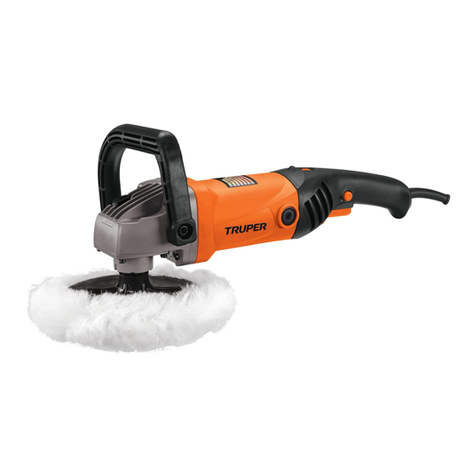
Truper
Truper PULA-7A3 User manual
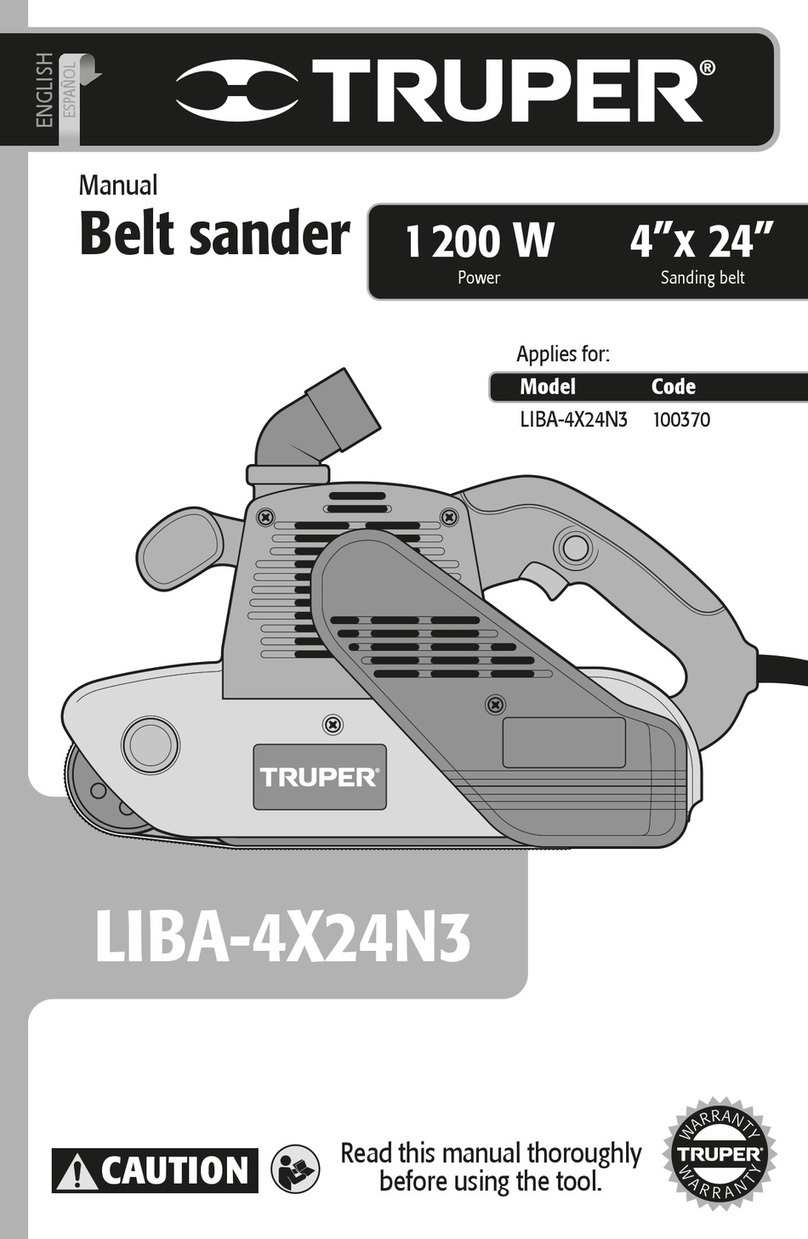
Truper
Truper LIBA-4X24N3 User manual
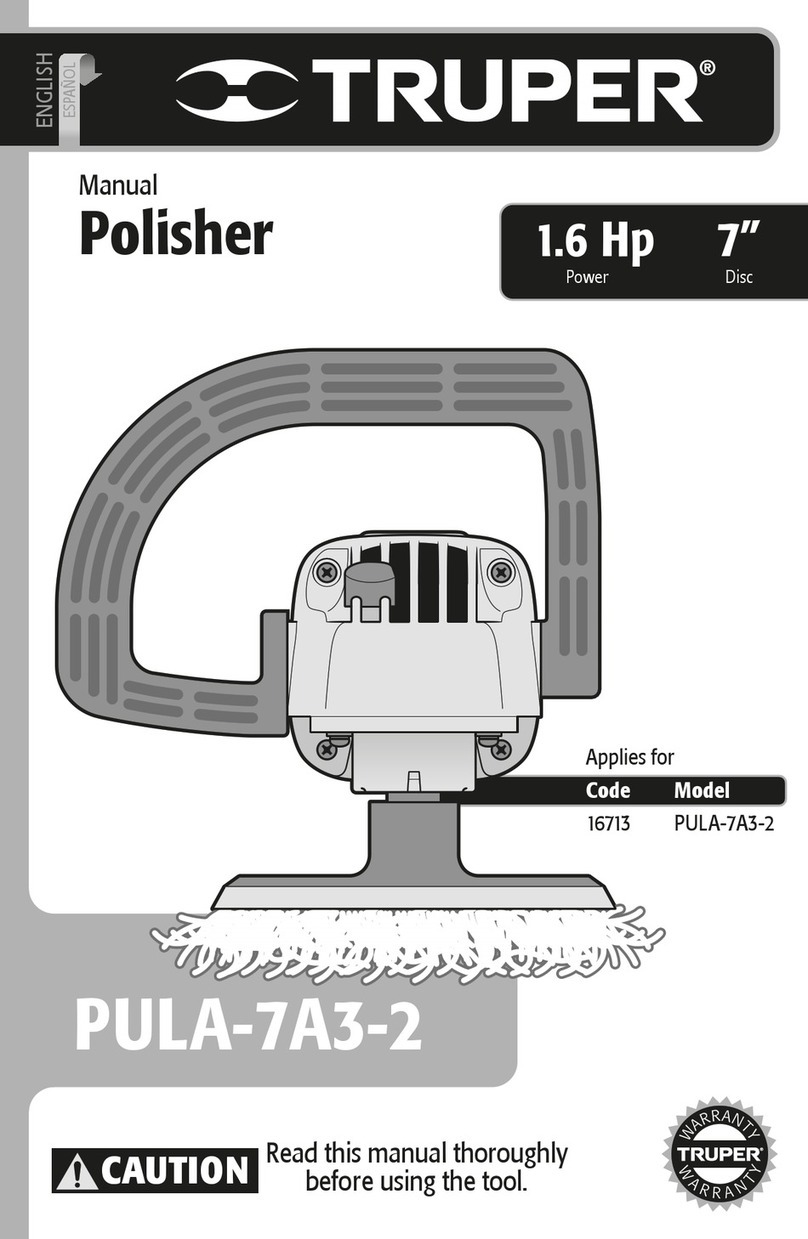
Truper
Truper PULA-7A3-2 User manual
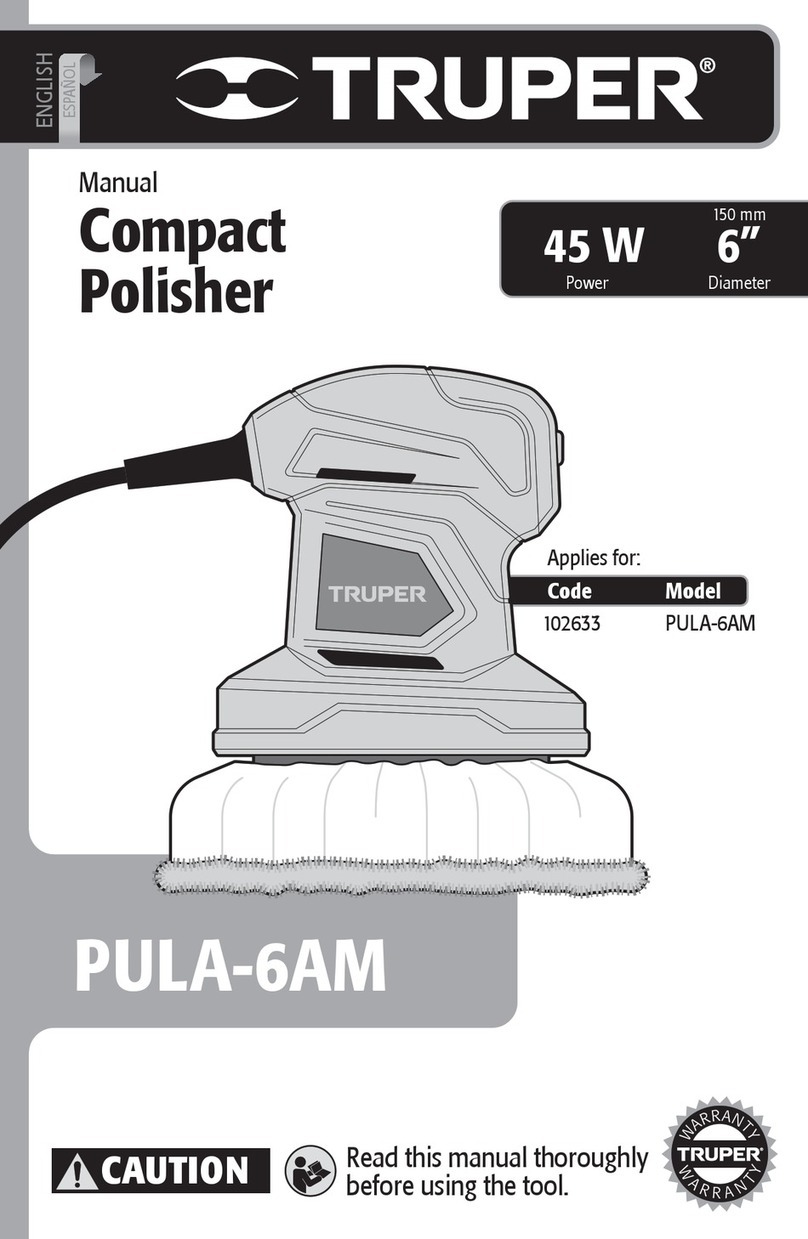
Truper
Truper PULA-6AM User manual
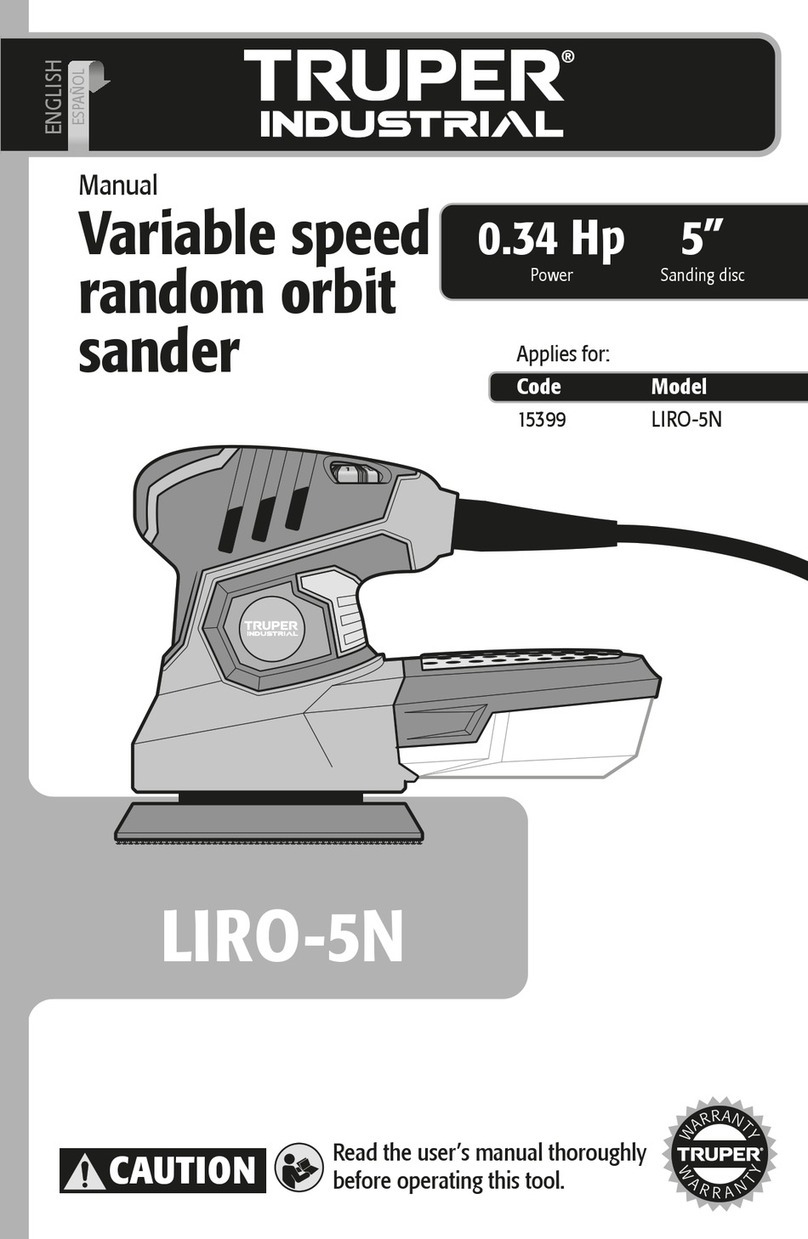
Truper
Truper LIRO-5N User manual
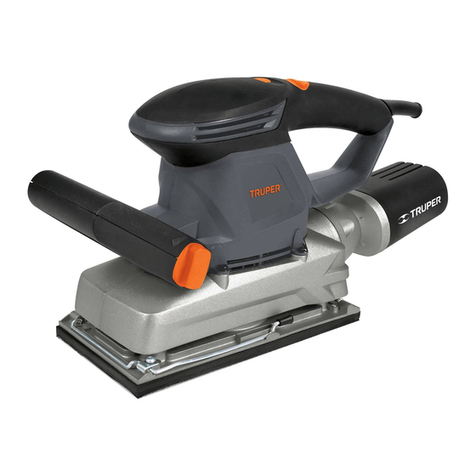
Truper
Truper LIOR-1/2NX User manual
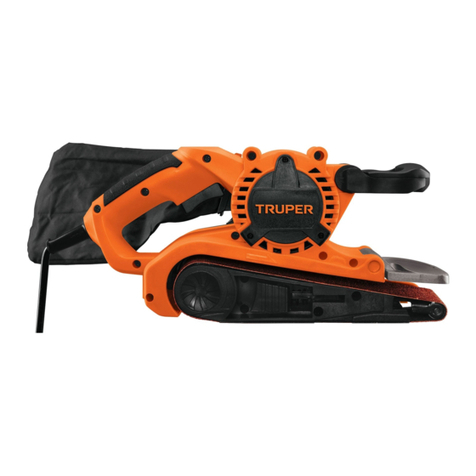
Truper
Truper LIBA-3X21A2 User manual
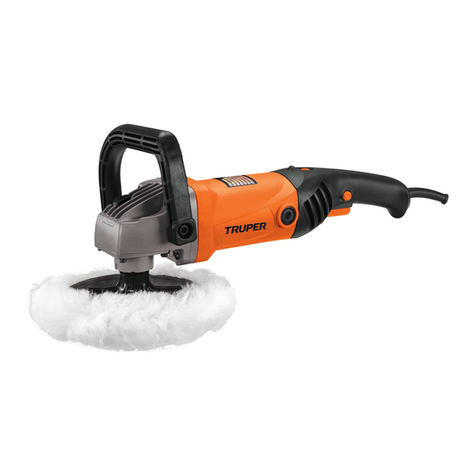
Truper
Truper PULA-7A3-2 User manual
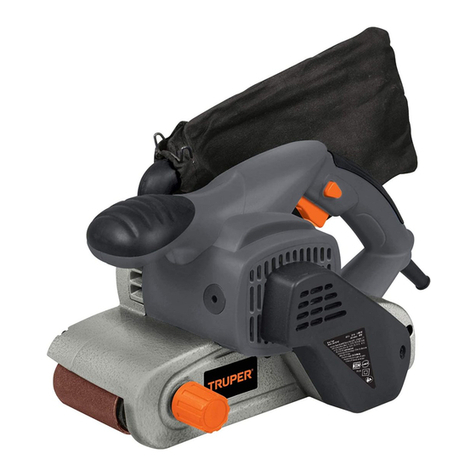
Truper
Truper LIBA-3X21N2 User manual
Popular Sander manuals by other brands

Sparky Group
Sparky Group MBS 776 Original instructions
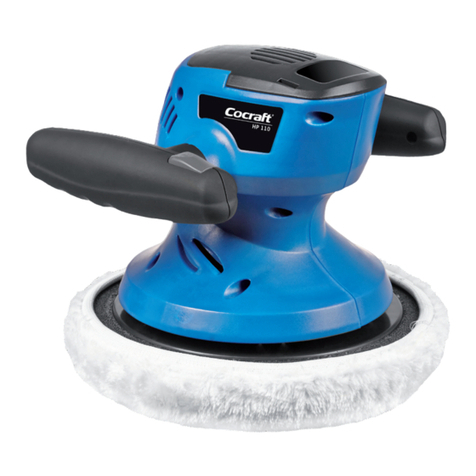
Cocraft
Cocraft HP 110 Original instructions

Dynabrade
Dynabrade Dynorbital-Spirit 59000 Safety, operation and maintenance

MachineryHouse
MachineryHouse DS-1632 instruction manual
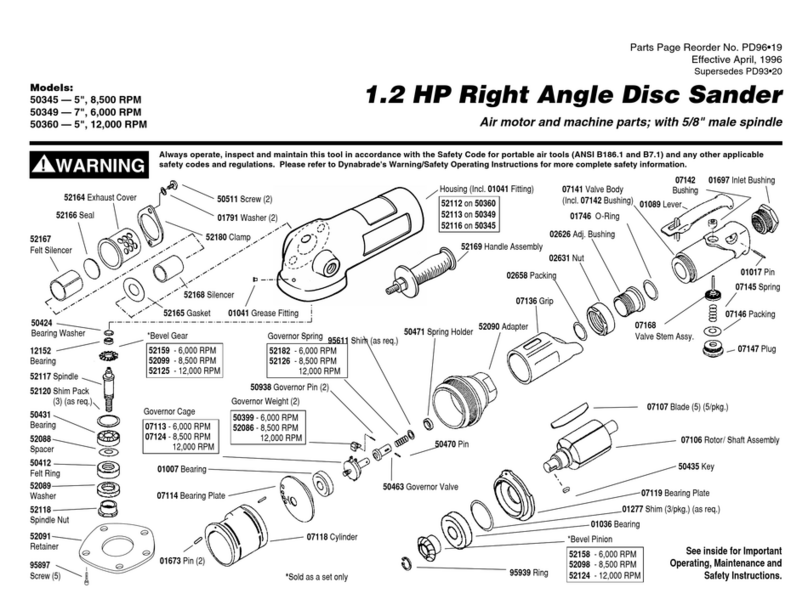
Dynabrade
Dynabrade 50345 instructions
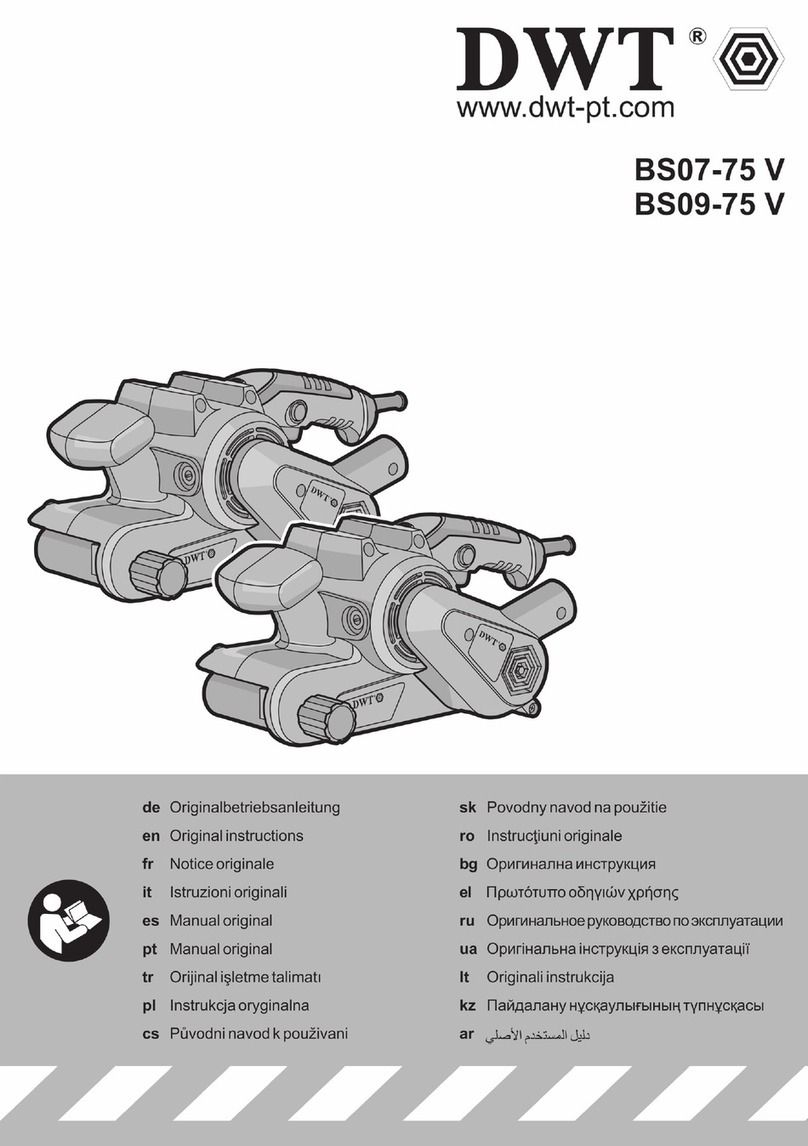
DWT
DWT BS07-75 V Original instructions


